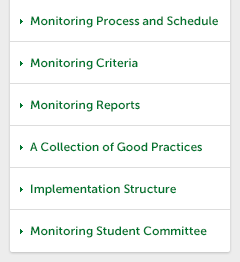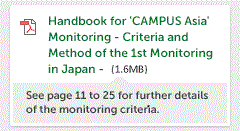
Monitoring Criteria
The monitoring framework in Japan is comprised of seven criteria. Each criterion provides examples of good practices and a rubric for analyzing quality level.
Criteria for the 1st Monitoring in Japan |
Criterion 1: Goals of Academic Program Criterion 2: Teaching and Learning Criterion 2-1: Organization and Staff  Criterion 2-2: Contents of Academic Program  Criterion 2-3: Support for Learning and Living  Criterion 2-4: Credit Transfer and Grading System  Criterion 3: Learning Outcomes  Criterion 4: Internal Quality Assurance System  |
Examples of good practices are given to monitored program providers to facilitate self-description of their own successful practices and effective measures for resolving problems in international educational programs through self-analysis.
The rubric for analyzing quality level is intended for use as a tool in self-analysis to determine the extent to which quality education is assured in the monitored program. A detailed description is supplied for each of the four dimensions of every criterion so that program providers can judge whether the types of content implemented have fulfilled that dimension.
The monitoring committee established criteria for the first monitoring in Japan based on the discussions in the ‘CAMPUS Asia’ Provisional Committee organized by NIAD-UE and exchanges of opinions with monitored program providers through liaison meetings with program representatives and through individual interviews.
The committee analyzed self-analysis reports, conducted document studies and site visits in light of the criteria.





